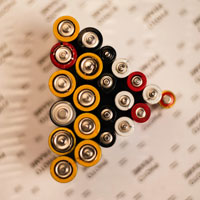4 Tips for Safely Packing and Shipping Li-ion Batteries
 Li-ion batteries are so ubiquitous these days that we rarely think they can pose any danger. Shipping services and airlines, however, classify them as dangerous goods because batteries are sensitive to environmental factors and can explode while in transit. This is why it is important to properly pack Li-ion batteries before shipping.
Li-ion batteries are so ubiquitous these days that we rarely think they can pose any danger. Shipping services and airlines, however, classify them as dangerous goods because batteries are sensitive to environmental factors and can explode while in transit. This is why it is important to properly pack Li-ion batteries before shipping.
Figure Out What Batteries You Can and Cannot Ship
First of all, you need to know the difference between lithium metal batteries and lithium-ion (Li-ion) batteries. To put it simply, most lithium-metal batteries are primary, i. e. disposable; they are designed to be used once and then discarded. Li-ion cells and batteries are secondary, i. e. rechargeable; they can be found in consumer electronics such as portable devices and power tools.
Not every courier ships lithium-metal batteries, but Li-ion batteries are usually allowed for shipment as long as they meet certain requirements and are safely packed. Generally, lightweight packages containing Li-ion cells with a maximum rating of 20 Wh and batteries with a maximum rating of 100 Wh do not need to be classified as fully regulated dangerous goods.
However, it’s best to contact your chosen shipping carrier to get all the necessary information regarding the shipment of Li-ion batteries and clarify all the details, as well as to check out the import rules of the destination country if you’re shipping lithium-ion batteries or devices containing them internationally.
Keep in mind that you’re are not allowed to ship damaged or defective batteries, and waste batteries intended for recycling cannot be shipped by air without a special permit from the national authority and airline.
Use Reliable Packaging and Protect Terminals
Strong, high-quality outer packaging and cushioning material inside the box will protect Li-ion batteries from environmental factors, other items in the package, and each other. It is especially important to protect battery terminals in order to prevent short circuiting or sparking. Make sure that terminals are covered with non-conductive insulation and that each battery has its own interior packaging.
Take Precautions When Shipping Batteries in Devices
When shipping equipment with built-in Li-ion batteries, such as smartphones, laptops and portable medical devices, you need to take special precautions. Before packing the device, make sure that the battery isn’t bulging out of it. Turn off the device, put a protective cap on its switch to keep the device from accidentally activating while in transit, and make sure to use enough cushioning material to prevent the device from movement that might result in accidental activation.
Properly Label the Package
Even if the batteries you’re shipping are not classified as fully regulated dangerous goods, you are still required to properly label the package to let the carrier know that there are Li-ion batteries inside. Requirements for the use of labels and markings depend on whether the battery is contained in equipment or not.
The dangerous goods label must be clearly visible and not covered by packing tape or anything else. Dangerous goods labels are typically diamond-shaped, and it is important that you place them properly (at a 45° degree angle) without folding them over the edge of the box so that they can be immediately identified.
If your shipment requires a shipper’s declaration for dangerous goods, you should put the declaration in a special clear plastic pouch and securely tape it to the package with clear packing tape. Some couriers also require to add an emergency contact phone number when shipping dangerous goods (though if your package has an international shipping label, it should already have a phone number on it).